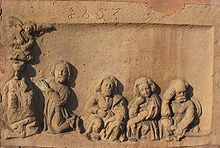Marlenheim
| Marlenheim | ||
|---|---|---|

|
|
|
| region | Grand Est | |
| Department | Bas-Rhin | |
| Arrondissement | Molsheim | |
| Canton | Molsheim | |
| Community association | Mossig et Vignoble | |
| Coordinates | 48 ° 37 ′ N , 7 ° 30 ′ E | |
| height | 175-365 m | |
| surface | 14.59 km 2 | |
| Residents | 4,250 (January 1, 2017) | |
| Population density | 291 inhabitants / km 2 | |
| Post Code | 67520 | |
| INSEE code | 67282 | |
 Marlenheim Palace, today the town hall ( Hôtel de Ville ) |
||
Marlenheim is a French commune with 4250 inhabitants (as of January 1, 2017) in the Bas-Rhin department in the Grand Est region ( Alsace until 2015 ). It is the northernmost place on the 170 km long Alsace Wine Route and has therefore been officially called Porte de la Route des Vins d'Alsace since 1994 . The community is a member of the community association Communauté de communes de la Mossig et du Vignoble .
geography
Marlenheim is 15 kilometers west of Strasbourg in the Upper Rhine Plain . The Kochersberg connects to the north, and the two to three kilometer wide strip of the Alsace wine-growing region continues to the south between the Vosges in the west and the Rhine plain in the east. Marlenheim is affected by the Mossig .
history
According to archaeological finds - flint stones and ceramics - the area around Marlenheim was already settled in the Hallstatt period. Pottery and sarcophagi have also been found from Roman times.
As a presumed Merovingian foundation Marilegium , Marlenheim was first mentioned in the 6th century. Gregory of Tours reports that King Childebert II owned vineyards here in 589; this is the oldest known written record of Alsatian wine. In the 7th century Dagobert I donated these vineyards (only the current location can be stone blocks ) to the Niederhaslach monastery founded by Florentius of Strasbourg .
After the reign of the Carolingians , Marlenheim shared the history of Alsace .
After changing ownership in the Middle Ages (destruction by the Armagnacs is documented in 1444 ), Marlenheim became an outpost of the Free City of Strasbourg through the Treaty of Haguenau in 1604. During the Thirty Years' War , the community adhered to Catholicism. The story goes that the local population first made the company of Swedish troops drunk with wine and then murdered them. During the Franco-Dutch War , Henri de Latour d'Auvergne, Viscount de Turenne moved into quarters in Marlenheim in 1674 after crossing the Rhine near Philippsburg and conquering the Palatinate.
In 1864, the construction of the railway line from Molsheim to Saverne initiated the industrial age in northern Alsace. Between 1908 and 1953 an overland route of the Strasbourg tram ran via Marlenheim to Westhoffen .
The expansion of Marlenheim as a tourist destination began after the Second World War, especially with the establishment of the Alsace Wine Route in 1953.
Marlenheim was the administrative center and member of the communauté de communes de la Porte du Vignoble , founded in 1994 , which was merged into the Communauté de communes de la Mossig et du Vignoble in 2017 .
Population development
| year | 1962 | 1968 | 1975 | 1982 | 1990 | 1999 | 2006 | 2009 | 2011 | 2013 |
| Residents | 1,512 | 1,823 | 2,287 | 2,822 | 2,956 | 3,365 | 3,477 | 3,652 | 3,806 | 4,005 |
Economy and Social
Marlenheim lives from agriculture, viticulture and tourism.
The village structure is characterized by retail stores and service providers, cafes, restaurants and wine bars.
On the outskirts of the community there are three areas for commercial operations, especially for office furniture and interior fittings, as well as shopping centers with 1000 employees.
From a socio-cultural perspective, Marlenheim forms an interest group ( Communauté de communes de la Porte du Vignoble ) with the six surrounding communities of Dahlenheim , Kirchheim , Nordheim , Odratzheim , Scharrachbergheim-Irmstett and Wangen in child and youth work and for cultural events.


Attractions
The main street ( Rue du Général de Gaulle ) and its traffic-calmed side streets are characterized by half-timbered houses from the Renaissance, some with stair turrets and bay windows.
- The church from 1716, consecrated to the local saint Richardis , still has a Romanesque portal.
- The neoclassical style castle (now the Hôtel de ville ) dates from the 19th century.
- The 18th century department store is on the market square .
- The medieval half-timbered post office with inner courtyard has been a hotel and gourmet restaurant since 1930.
- There are a few watermills outside the village on the Mossig.
Viticulture
Marlenheim has the northernmost vineyards on the Alsace Wine Route. Of the 132 hectares of vineyards in the Steinklotz single vineyard , 40.6 hectares are designated as Grand Cru . The sunny southern exposure of this slope also enables the production of Vendanges Tardives , which - regardless of the literal translation - are not Spätlese wines but denote wines with a minimum must weight that corresponds to a German grade between Auslese and Beerenauslese .
The most important grape variety that has been grown here since the Middle Ages is Pinot Noir (26% of the area), the most common white grape varieties are Riesling (18%), Gewürztraminer (12%), and Pinot Gris (7%), Sylvaner , Pinot Blanc , Muscat and Auxerrois .
A 1½-hour educational wine trail ( Sentier Viticole Marlenheim ) through a demo vineyard explains the varieties and cultivation methods. A path of the cross with a chapel (18th century) is integrated into the path, which can be walked all year round, apart from the reading time.
The oldest and largest winery in Marlenheim (since 1577, represented with 23 hectares of vineyards, public cellar tours and international sales) is Mosbach .
There are also about 30 smaller wineries in the Communauté . The wine and sparkling wine trading house Arthur Metz , founded in 1901, is also based in Marlenheim.
Cultural event
- Parish fair on March 18th
- Theater "Salon de l'Alsatique - Forum des Littératures Régionales", also in Alsatian German , in July in the odd years, also associated with art exhibitions
- Symbolic wedding of Ami Fritz on August 15 (figure from a novel by Erckmann-Chatrian )
- Pilgrimage on September 23
- Wine festival on the 3rd Sunday in October
Community partnerships
Marlenheim is a sister of Rust in Baden-Württemberg , on the German side of the Rhine also in the Upper Rhine Plain and about 70 km away. There is also a partnership with the municipality of Bouillante , located in the French overseas department of Guadeloupe .
literature
- Le Patrimoine des Communes du Bas-Rhin. Flohic Editions, Volume 2, Charenton-le-Pont 1999, ISBN 2-84234-055-8 , pp. 1540-1547.
Web links
- Web presence on the Communauté de communes website (French)
- Marlenheim on cc-porteduvignoble.fr (French)
Individual evidence
- ^ Marlenheim on the INSEE website
- ↑ db-city , accessed on November 11, 2014

